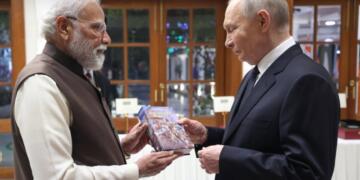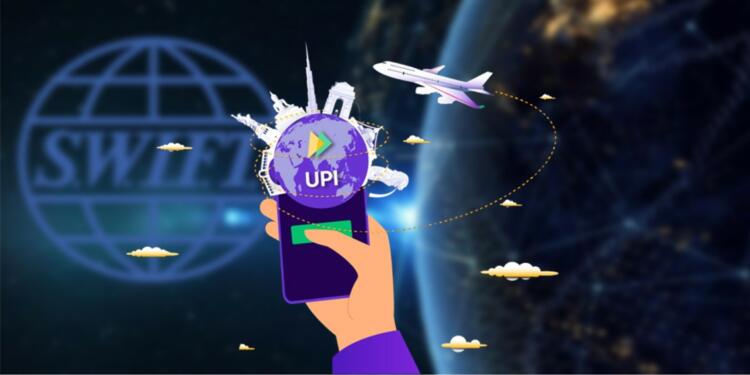If there is one lesson that the whole world including Ukraine can learn from the Eastern European confrontation, then it is clear that one should never rely on Western powers and it is particularly true for economic dependence. Relying on SWIFT just choked Russia’s economy in a massive way. With a click of the button, Russian assets were frozen. For India, it meant a push for greater acceptability of UPI.
UPI as a replacement for SWIFT?
National Payments Corporation of India (NPCI) has begun the process of making it easier for expatriates to send money to India. According to Ritesh Shukla, NPCI International Payments Ltd, it is an apt time to change the dynamics of remittances coming to India. Possibly, global economic hegemons being more focused on stopping Russia is one of the situations India can take advantage of.
Explaining how NPCI’s infrastructure will make it easy for cross-border trade, Shukla said “We have displaced cash in India to a large extent and are now looking to repeat the success in cross-border corridors. Overseas Indians can use our rails to remit money inwards straightway into their bank accounts, and for the markets where Indians travel frequently, we will build acceptance for our instruments.”
Read more: GPay and AmazonPay control the lion’s share of UPI economy and Indian players need to rise up
SWIFT can’t be relied upon
The reason why India is upscaling UPI on a massive level and that too outside India is due to the fact that like every other country, it has seen Russia struggling with SWIFT. As soon as the war started, one of the first sanctions Russia was slapped with was the SWIFT ban. At the time of the ban, Russia was heavily reliant on the SWIFT system for both cross-border and intra-national trade of its natural resources and other products. In a whip, every bank headquartered in Russia was thrown out of the International monetary system.
According to an estimate, the Russian economy is set to suffer a 5 percent loss on its Gross Domestic Product basis. The ban also targeted the $630 billion forex reserve in Russia. Though, Russia was preparing for it. Its own System for Transfer of Financial Messages (SPFS) was able to cut down the loss to 5 percent of GDP, but that number is too big, especially in the post-covid world.
SWIFT mainly protects European powers
It won’t be wrong to claim that SWIFT is run by western countries and that other participants have almost negligible say in its operations. It connects 11,000 banks and has 200 member countries. Despite it having 200 countries on board, only 10 central banks and 1 European Central Bank control it.
Belgium, Canada, France, Germany, Italy, Japan, Netherlands, Sweden, Switzerland, United Kingdom, and United States are the countries harnessing their central bank resources for SWIFT. Western countries are so protective of SWIFT that even its headquarter is located in Belgium, the same country in which the EU is headquartered. Just ponder upon this astonishing fact.
India is also a member of this group. It indeed provides lots of advantages to us. It makes our cross-border transactions easier. It makes it tough for corrupt people or companies/institutions to hide black money. Moreover, the transaction is transparent and easily verifiable. But, two risks are there as well. The first one is the accessibility of Indian Data to Foreign countries and by extension their companies. The second and more prominent risk is that like Russia, it can be used to choke India’s economy as well.
Read more: How RBI’s MasterCard ban is helping VISA, UPI and RuPay
Benefits of UPI
That’s where the role of UPI comes into play. Up until now, UPI has proved to be a largely secure platform. Its adaptability and 24*7 unhindered operations along with its simple interface make it easy to adapt. After the Chinese virus hit our supply chain, the use of UPI has seen a phenomenal rise. It touched its highest number of transactions in April 2022 with 558 crore total transactions, a 3 percent rise over March 2022. More than 316 banks are now available on the platform.
Read more: UPI has changed the way, how we Indians make payment
Slowly, UPI has expanded its footprints in other countries. Singapore, Malaysia, Thailand, Philippines, Vietnam, Cambodia, Hong Kong, Taiwan, South Korea, and Japan are a few countries that are set to launch UPI-based QR codes. France is on the way to accept UPI payments as well and after France, European countries are expected to follow suit.
After full acceptance, it will become easier for Indians to send remittances to India. India stands at first position when it comes to accepting remittances and Indians staying abroad sent $87 billion worth of remittance to their friends and families. But, the problem is that for every $100 they send, their family members get only $93.5. UPI will either eliminate this extra ‘surcharge’ or it will bring the cost down to negligible.
UPI as an alternative to SWIFT
Additionally, over a period of time, UPI will also provide the advantage of data localization. The critical data of Indians will be available to Indian authorities only, those whom we can question and drag to the Court of Law in case they go haywire. The legal process in SWIFT is tedious and involves multiple jurisdictions.
Availability, accessibility, and affordability are the three key features that any payment system needs to have in order to increase its market share. UPI has all the aforementioned features. The way it has gained traction in the last few years, it won’t be surprising if SWIFT becomes irrelevant for Indians. And lastly, it was being said that blockchain transaction process will revolutionize the way people transact but it looks like UPI and Rupay together are already doing it.
Support TFI:
Support us to strengthen the ‘Right’ ideology of cultural nationalism by purchasing the best quality garments from TFI-STORE.COM





























